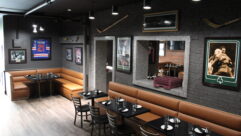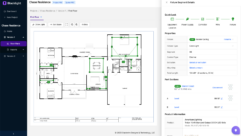
Installation Profile: One-of-a-Kind Design
Jun 1, 2006 12:00 PM,
By Daniel Keller
The new Busch Stadium makes a unique statement with high-impact AV.
The main scoreboard incorporates a 32’x52’ ProStar video display for full-color animations, as well as three amber LED displays for statistics and graphics.
Although many cities host major league sports franchises, St. Louis is one of a handful of towns that truly embrace their teams. The city’s relationship with the Cardinals baseball team dates back more than 100 years to the late 19th century, when the St. Louis Browns (which later became the Cardinals) played at Robison Park. When Annheuser-Busch took ownership of the team in 1953, they renovated and renamed Sportsman’s Park, the Cardinals’ venue at the time, Busch Stadium. The second Busch Stadium, opened in 1966, served the team and fans well for half a century, but it was one of the few remaining “cookie cutter” ballparks popular in the 1960s and ’70s, and the arrival of the new millennium brought a widespread desire for a new venue with a more distinctive feel.
The third stadium to carry the Busch moniker is a striking architectural statement that manages to evoke both classic and modern design. Unlike so many large monumental structures, which tend to fragment and dissect their neighborhoods, the park’s open-walled design creates a focal point that visually draws the downtown area together. The site of the new 43,975-seat park slopes downward about 40ft., a topography that architect HOK Sport used to its advantage by positioning home plate in the southwest corner. This provided most of the stadium’s seats with views of not just the field, but also the city’s landmark Gateway Arch and downtown skyline. Conversely, the adjacent Ballpark Village, a neighborhood being built on the grounds of the old stadium, will enjoy an open view into the park from its rooftops and balconies.
Construction on the new stadium began Jan. 17, 2004. The $365 million project was made all the more complex due to the new stadium’s footprint, which overlapped that of the existing field. As the new venue was being erected, parts of Busch II’s structure were closed off and torn down as needed, with the old park remaining open (albeit with reduced seating capacity) until completion of the 2005 season. After Busch II was closed, the simultaneous construction and demolition projects continued apace, with the new park officially opening its gates April 4, 2006, for a minor league game, and the first Cardinals game being held against the Milwaukee Brewers on April 10.
Even with the stadium officially open, construction is not yet completed. The field level, terrace level, and bleachers were constructed in time for opening day, while the pavilion, loge, and club levels — and approximately 6,000 seats in left field, located on the site of the old stadium — will not be available until the second half of the 2006 season.
THE CHALLENGES OF BEING DIFFERENT
General contractor Hunt Construction brought in Dallas-based acoustical consultant Wrightson, Johnson, Haddon & Williams (WJHW) to design the stadium’s highly sophisticated AV system, working with systems integrator SPL Integrated Solutions. The team faced a number of interesting challenges, not the least of which was the unique nature of the new stadium’s architecture. Much of the seating area incorporates a low overhead design to achieve an intimate environment. Although it’s effective architecture, it’s an added challenge for the systems designer.
“As the architectural design for the new stadium developed, it became obvious it would be more distinctive, more asymmetrical, with more of the quirks that give these new parks their personality,” Ron Baker, principal at WJHW, says. “There are lots of changes in elevation, and it’s fairly intimate in many areas. Parts of the system design challenge was coming up with solutions that could work within the constraints of the architecture and geometry of the building.”
The audio system uses no main line array, relying instead on a distributed system composed largely of EAW loudspeakers. “The objective was to get away from the traditional concept of putting a stack of speakers out in center field and blasting it back to the infield,” Baker explains.
“This is probably one of the most complex baseball stadiums we’ve done to date,” observes Fred Curdts of SPL’s Columbia, Md., offices. That’s hardly an insignificant statement from a company whose recent history includes the new homes of the Philadelphia Phillies, Milwaukee Brewers, and Pittsburgh Pirates, all high-tech projects in their own right. As Curdts points out, “Baseball stadiums are increasing in complexity and increasing in system output. Baseball used to be more low-key and low-fidelity, while football was the high-dynamic-range sport. Even as recently as the 1990s, we saw baseball stadiums incorporating more high fidelity, but not necessarily higher impact. Now, in this decade, we’re beginning to see systems in baseball stadiums being designed with the degree of dynamic impact and low-frequency power that was typically the province of football stadiums.”
“They told us from the outset they wanted a distributed system,” Baker says, “and the task fell to us to find a way to achieve a distributed, high-impact system for this architecture. The building’s design created a wide range of differing conditions, making it impractical to apply the same solutions across an entire level, for example. What we’ve created is a fairly complex arrangement, using a greater number of smaller zones. This gives the audience much closer proximity to the actual cabinet, with less influence from the weather and other ambient sounds, better bandwidth, less delay, and with lower overall dynamic levels. And while it’s not so much of an issue in this particular ballpark as it is in other urban areas, a fully distributed system also creates less ambient sound leakage into nearby neighborhoods.”
ALL SHAPES AND SIZES

Seating areas beneath low ceilings created intimacy in the stadium—as well as challenges for systems designers, who had to come up with workable solutions to deliver high-fidelity, high-impact sound. A distributed sound system employing more than 20 different types of speakers was used.
“As with any distributed system, each architectural area becomes its own zone,” Curdts says. “The various different geometries call for different loudspeaker types and configurations. We’re using over 20 different types of speakers, with over 500 cabinets in the seating bowl.”
The low ceilings add to the equation. “The boxes’ lower height means less coverage per box,” Baker explains. “It takes more units, spaced closer together, to achieve an acceptable level of coverage. Of course, the inevitable challenge is that the more boxes you use, the more interference with sightlines.”
And sightlines, as Curdts observes, are always a major consideration. “It’s the typical divergence between architecture and sound design. The architects don’t want to see the speakers, but a speaker is essentially a line-of-sight technology, and if you don’t see it, it’s probably not doing a good job.”
The system uses approximately 400 EAW MK series loudspeakers, a compact two-way system with a wide range of configurations and dispersion patterns. “The EAW line is pretty comprehensive, allowing us a lot of flexibility in configuring cabinets for each area,” Baker reports, “and it’s well-suited for some of the unique mounting conditions we faced. Sightlines are always an issue, and you don’t always have the luxury of hanging cabinets where you’d like to. The EAW cabinets allow the horn section to be rotated, so you can hang them horizontally and still get the wide coverage necessary for this application. There’s a variety of horn patterns as well — the MK series has something like a dozen different configurations. We’ve used them in a number of other venues and felt comfortable in knowing what to expect in terms of performance.” JBL Control 30 and Lowell ceiling speakers serve some additional areas, including concourses, concessions, and restrooms.
While a few of the long-throw EAW cabinets are bi-amped, most of the speakers are running full-range with passive crossovers, powered in pairs at 8Ω per cabinet. This provides many channels of amplification, handled by nearly 200 Crown CTs series amplifiers in two amp rooms located down the first- and third-base sides. Crown’s IQ control network allows for control and monitoring of the amplifiers’ performance.
LONDON CALLING
The new stadium is also one of the first large-scale implementations of BSS’ new Soundweb London system, using 11 BLU-80 processor units and five BLU-32 I/O expanders. “The original system design specified the first generation of SoundWeb,” Curdts explains, “but we made the decision early on to go with the London. Despite it being an untried product, we felt that the long-range benefits outweighed any risk.”
That said, every engineer knows to approach version 1.0 of any new product with extra attention. “We expressed some concern early on to the folks at Harman, who own both Crown and BSS, that we were implementing their new product into quite a high-profile venue, and their response was very proactive,” Baker says. Both companies provided a team of senior-level engineers onsite, who, along with WJHW’s Jack McCallum and SPL’s project engineer Justo Gutierrez and project manager Skip Warrington, spent several weeks completely testing the full system and the integration of the London and Crown IQ systems.

Seating areas beneath low ceilings created intimacy in the stadium—as well as challenges for systems designers, who had to come up with workable solutions to deliver high-fidelity, high-impact sound. A distributed sound system employing more than 20 different types of speakers was used.
Both Baker and Curdts report they are quite pleased with the London’s performance. “To me, one of the most significant aspects of the London is that it works over standard Ethernet,” Curdts observes. “Parts are readily available, and if a switch goes down you can pick one up almost anywhere. With the older SoundWeb’s proprietary stuff, any minor problem has the potential to become far more catastrophic.”
COMMAND CENTRAL
The audio control room houses a Midas Verona mixing desk with 24 mono and eight stereo channels. Microphones comprise a selection of Electro-Voice RE-18 and RE-20, Audix OM6, and Shure Beta 58A, as well as Shure U4D wireless systems. Additional audio sources include Tascam CD-01U and Marantz PMD371 CD decks, Yamaha DVD-C950, and Roland AR-3000 message repeater and AR-200 secondary units, all in Middle Atlantic racks.
Signal processing includes BSS FCS-960 and DPR-901 equalizers, Symetrix 528E vocal processor, dynamics from Aphex and dbx, and dbx Zone Pro 1260 and 640 digital signal processors. Also in the rack is a LynTec Crowd Comp noise compensation system with remote-sensing microphone.
SBC Communications coordinated most of the low-voltage design and brought in St. Charles, Mo.-based Telecom Services Installation (TSI) to coordinate the massive conduit and cabling task. “TSI really did an excellent job,” Curdts reports. “The success in completing such a complex job in such a particularly tight time frame is largely owed to TSI.”
With more than a million feet of audio cabling alone, as well as standard- and high-definition video, fiber-optic, and intercom systems, TSI specified Belden Brilliance broadcast and AV cabling for the job. “Belden CDT Electronics also offered us value-added services, such as custom cutting and labeling the cables and onsite installation training,” adds Mark Schultz, TSI’s design specialist on the job. “Local support is a tremendous advantage, especially for such a complex project.” Belden products used include 1694A precision video coaxial cable, 8477 paired copper speaker/control cable, 1816R analog multi-pair snake cable, 9451 line-level analog audio cable, and YR46898 speaker cables.
DISPLAYS FOR DAYS
The stadium’s video systems are equally impressive. Fifty-six LED displays are employed, 10 of which are full-color Daktronics ProStar video screens capable of displaying up to 4.4 trillion shades of color. In all, the stadium’s 9,300 square feet of displays use more than 2.3 million individual LEDs.

St. Charles, Mo.-based Telecom Services Installation (TSI) specified Belden Brilliance AV cabling to meet the stadium’s extensive conduit and cabling needs.
The main scoreboard, positioned behind right center field, measures approximately 40ft. high by 120ft. wide and incorporates a 32’×52′ ProStar video display for full-color animations, as well as three amber LED displays for statistics and graphics, and several static and rotating panels to display the logos of the team’s corporate sponsors.
Like many newer ballparks, Busch Stadium’s video is enhanced by a full-color display incorporated along the fascia of one of the upper seating decks. Two 150ft. Daktronics ProRail RGB displays are mounted on the second deck along the first and third base lines, creating visual continuity with the main scoreboard’s display and providing statistics, video clips, and sponsors’ messages.
Near the main scoreboard is the Coke Deck, where a 6’×10′ ProStar display shows game replays and highlights, ads, and other information. And in right field is the “Out of Town Game” scoreboard, a 15’×80′ ProStar display that provides continuously updated scores and highlights from other National and American League games in progress.
Over the right- and left-field bullpens, a pair of 4’×20′ pitchers’ displays provide statistics and other information about each team’s current pitcher. Two more displays on the lower fascia in far right and left field display the speed and type of pitch.
IT’S ABOUT TIME AND SPACE
If the complexity involved in the system design wasn’t enough, the construction schedule itself added several more layers of logistical challenges to the project, creating both a highly compressed schedule and a very crowded work environment. “The demolition phase was designated to begin at the end of the season,” Curdts recounts. “Then the team made it into the playoffs which, while good news for the fans, extended the season, further shrinking an already tight window, and putting us into the dead of winter.”
“The logistics of building the stadium so close to the old facility certainly impacted everyone with its added complexity,” Baker confirms. “Perhaps the last 35 percent of the new stadium could not be constructed until the old stadium came down. Once the season was over and all the trades went to work in November, we essentially had two simultaneous projects, with twice as many tradespeople, running on a 24/7 work schedule.”
The new stadium has received enthusiastic responses from fans, players, and media alike. Broadcasts from the park look and sound positively stellar, and even the fussiest fans are taking the temporary inconvenience of the ongoing construction in stride — perhaps because they know the challenging nature of the project.
For the principals involved in the systems’ design, the results are particularly gratifying. “SPL has done a number of projects with WJHW, and we have developed an excellent working relationship,” Curdts reflects. “The contract for both SPL and WJHW on this project was what is referred to as a ‘design assist,’ where both companies were given an increased level of design responsibility. We expect in the future to see more collaborations like this between contractor and consultant. We’ve found it helps to control costs, because both parties work in much closer coordination, and you’re dealing in real numbers instead of estimates. And the end result speaks for itself.”
Ron Baker sums it up: “We were all very conscious going into it that this ballpark had a legacy, and we’re happy to have been able to honor that legacy.”
For More Information
Aphex
www.aphex.com
Audix
www.audixusa.com
Belden
www.belden.com
Crown
www.crownaudio.com
Daktronics
www.daktronics.com
EAW
www.eaw.com
Electro-Voice
www.electrovoice.com
Lowell
www.lowellmfg.com
LynTec
www.lyntec.com
Marantz
www.marantz.com
Middle Atlantic
www.middleatlantic.com
Roland
www.roland.com
Shure
www.shure.com
SPL Integrated Solutions
www.splis.com
Symetrix
www.symnetaudio.com
Tascam
www.tascam.com
Telecom Services Installation (TSI)
www.tsi-inc.com
WJHW
www.wjhw.com
Yamaha
www.yamaha.com










